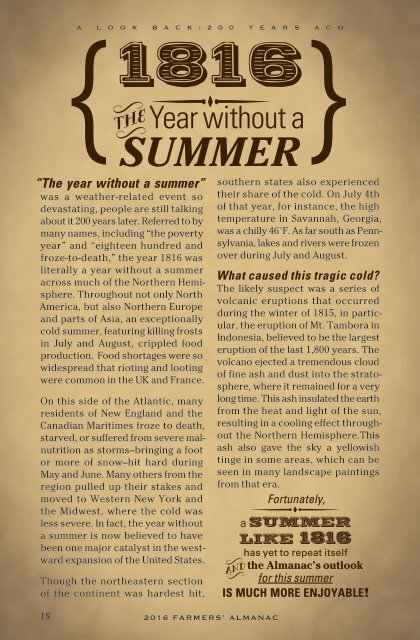Create successful ePaper yourself
Turn your PDF publications into a flip-book with our unique Google optimized e-Paper software.
A L O O K B A C K : 2 0 0 Y E A R S A G O<br />
1816<br />
Year without a<br />
SUMMER<br />
“The year without a summer”<br />
was a weather-related event so<br />
devastating, people are still talking<br />
about it 200 years later. Referred to by<br />
many names, including “the poverty<br />
year” and “eighteen hundred and<br />
froze-to-death,” the year 1816 was<br />
literally a year without a summer<br />
across much of the Northern Hemisphere.<br />
Throughout not only North<br />
America, but also Northern Europe<br />
and parts of Asia, an exceptionally<br />
cold summer, featuring killing frosts<br />
in July and August, crippled food<br />
production. Food shortages were so<br />
widespread that rioting and looting<br />
were common in the UK and France.<br />
On this side of the Atlantic, many<br />
residents of New England and the<br />
Canadian Maritimes froze to death,<br />
starved, or suffered from severe malnutrition<br />
as storms–bringing a foot<br />
or more of snow–hit hard during<br />
May and June. Many others from the<br />
region pulled up their stakes and<br />
moved to Western New York and<br />
the Midwest, where the cold was<br />
less severe. In fact, the year without<br />
a summer is now believed to have<br />
been one major catalyst in the westward<br />
expansion of the United States.<br />
Though the northeastern section<br />
of the continent was hardest hit,<br />
southern states also experienced<br />
their share of the cold. On July 4th<br />
of that year, for instance, the high<br />
temperature in Savannah, Georgia,<br />
was a chilly 46°F. As far south as Pennsylvania,<br />
lakes and rivers were frozen<br />
over during July and August.<br />
What caused this tragic cold?<br />
The likely suspect was a series of<br />
volcanic eruptions that occurred<br />
during the winter of 1815, in particular,<br />
the eruption of Mt. Tambora in<br />
Indonesia, believed to be the largest<br />
eruption of the last 1,800 years. The<br />
volcano ejected a tremendous cloud<br />
of fine ash and dust into the stratosphere,<br />
where it remained for a very<br />
long time. This ash insulated the earth<br />
from the heat and light of the sun,<br />
resulting in a cooling effect throughout<br />
the Northern Hemisphere.This<br />
ash also gave the sky a yellowish<br />
tinge in some areas, which can be<br />
seen in many landscape paintings<br />
from that era.<br />
Fortunately,<br />
a summer<br />
like 1816<br />
has yet to repeat itself<br />
the Almanac’s outlook<br />
for this summer<br />
is much more enjoyable!<br />
18<br />
<strong>2016</strong> FARMERS’ ALMANAC


